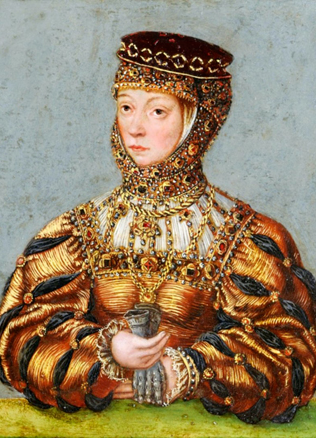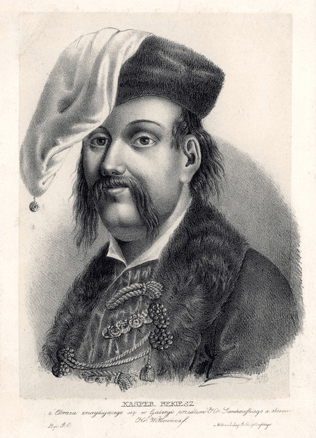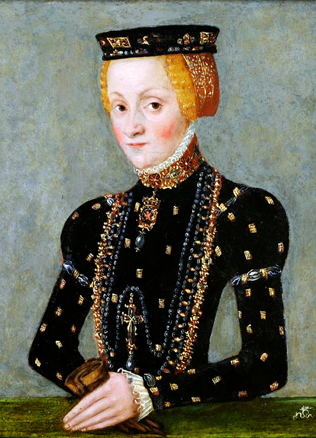The Alšėniškai (Olshanski) family – Lithuanian Dukes in Kiev
The historical sources mention that the Alšėniškiai family lived far from Kiev. Perhaps at that time they were not even dukes. The first testified representative of the family Algimantas was settled in Aristava located on the River Nevėžis. The chronicler of the Teutonic Order Hermann Wartberg called him “Grand satrapas” (this is what the influential Lithuanian great nobles were titled by the Order at that time). After the attacks of the Order in the second half of the 14th century, Algimantas had to leave his old patrimony and move to Alšėnai (Olshany), which was some distance away from the zone of military incursions. In the long run the name of this locality was taken over by his descendents who started calling themselves Dukes of Alšėnai (Olshany). Algimantas’ son Jonas was Jogaila’s brother in arms and took part in Dovydiškės hunting, later represented the Grand Duke in the negotiations over the coronation in Cracow. Later he went over to his close relative Vytautas (they were married to sisters) with whom he fled to Prussia, to the territory of the Order. The detail of the customs of those times (rarely found in the sources) reflects his attempt to reconcile himself with Jogaila: Jonas Algimantaitis presented Jogaila with a golden belt through the intermediating Vytautas. After Vytautas became Grand Duke of Lithuania a new stage of the career of the Alšėniškiai (Olshanski) family began, which led them to the most significant Ruthenian city of the Grand Duchy of Lithuania – Kiev.
“Taming”of Kiev
Residents of Kiev, at that time called “mother of all cities of Rus” preserved the exclusive status of their city and resisted any attempts to equate it to other lands of the Grand Duchy of Lithuania. The Grand Duke could entrust a person of the highest rank only with governing such a city and its environs. And the fact that the latter had to win the trust of the local people is testified by the tragic fate of Jogaila’s brother Skirgaila who was poisoned in Kiev in 1394. Therefore by Vytautas will, Jonas Algimantaitis who had to replace Skirgaila encountered a difficult task. The Orthodox baptism of Jonas (Ivan) was a favourable circumstance, which brought the Duke of Lithuanian origin closer to the Kiev nobility and the town-dwellers. Jonas Algimantaitis coped with the task successfully – this is testified by Vytautas’ decision to give over governing of Kiev after Jonas’ death to his sons. Hence, the Alšėniškiai family became the “first Lithuanian dynasty of the Dukes in Kiev” the importance of whose ruling to the continuity of the old Dukedom of Kiev in the 15th century is testified to by the inscription in the book of the local religious centre – Kiev-Pechersk Lavra – in memory of the dead, “the Grand Dukes of Kiev”.
“
Family became the “first Lithuanian dynasty of the Dukes in Kiev”.
Though the Alšėniškiai family ruled in Kiev only for several generations they preserved relations with that Ukrainian land by building the link between the patrimonial estate of Alšėnai (Olshany) and the castles and Orthodox churches of distant Kiev. Members of their family were buried in Kiev, orthodox believers-monks prayed for the souls of the living and dead Alšėniškiai there. They further remained symbolic Dukes of Kiev to the local population.
It is not by chance that the Alšėniškiai (Olshanski) Dukes played a decisive role in the birth of the new Lithuanian myth of Kiev. According to the legend recorded in the chronicles of Lithuania, during Gediminas’ marches the ancestor of Olshanski Algimantas, as a deputy of the first Grand Duke, became established in Kiev, which became “the nobody’s land” after the attacks of the Tartars. Thus the dukes of Alšėnai (Olshany) brought back the political significance to the city and created the dynasty, which could be regarded as their own. This story of taking peaceful possession of Kiev fitted the political doctrine of the Grand Duchy of Lithuania very well, the local aristocracy of Kiev and the tradition of the family’s power.
In the vortices of the GDL policy
Perhaps it was the ruling of Kiev and marriages of the Alšėniškiai (Olshanski) daughters (one of them became Vytautas’ second wife, another became Jogaila’s fourth wife) that enabled this family to feel its nobleness and align with the ruling Gediminds dynasty. The honourable armorial motif – the symbol of Centaur (Hippocentaur) that was wide-spread in the world of Catholics and Orthodox believers – reflected the family’s prestige. In the course of the entire 15th century the Alšėniškiai (Olshanski) are constantly found among the participants in the main political events of the Grand Duchy of Lithuania. The sons of Jonas Algimantaitis looked for a place for themselves in a changing political atmosphere and the names given to them by the contemporaries reflected characters developed by the epoch marked by conflicts. In 1405, Aleksandras Alšėniškis (Alexander Olshanski), called Neliubas, fled to the Dukedom of Moscow where he was given Perejeslavl to rule. In 1420, his brother Simonas Alšėniškas (Simon Olshanski), at Vytautas’ commission, went to rule Veliky Novgorod and because of his character was named The terrible (Luty). Simonas Alšėniškis fought on the side of Žygimantas Kęstutis in the struggles for the throne of the Grand Duke that started after the death of Vytautas and was an important organiser of the conspiracy of Alšėniškiai (Olshany) against Švitrigaila. In 1433, during Švirtigaila’s campaign he was taken prisoner, and by order of the enraged overthrown Ruler Simonas Alšėniškis was drowned in the river. The circumstance that at that time his brother, Duke of Kiev Mykolas, was in the camp of Švitrigaila, one of the most merited military leaders of the same march, makes the tragic element of the situation more pronounced. Shocked by the fate of his brother, Mykolas withdrew not only from the military camp but also from political life and spent his days quietly in the estates that belonged to his Ukrainian wife. Jurgis, the son of killed Simonas, who contributed significantly to the election of Casimir Jagiellonczyk, the Ruler of the Grand Duchy of Lithuania, chose active politics. Later a part of the Alšėniškiai family went over to Catholicism, and in the 16th century Paulius Alšėniškis (Paul Olshanski) became Vilnius Bishop.
Memory of the extinct family comes back to life in the land of Kiev
During the entire period of dramatic events Kiev remained the place to which the Alšėniškiai (Olshanski) family returned to pray at the graves of their family members, renewed personal relations with the local nobility and the clergy. They generously supported local Orthodox churches and monasteries in which unmarried girls and widows from their family lived. The epilogue of the Alšėniškiai (Olshanski) tradition in Kiev dates to the middle of the 17th century, a century after the death of the last representative of the family, and the city belonged to the Crown of Poland for a long time.
“
During the entire period of dramatic events Kiev remained the place to which the Alšėniškiai (Olshanski) family returned to pray at the graves of their family members, renewed personal relations with the local nobility and the clergy.
According to the descriptions that spread later, the remains of Juliona Alšėniškė (Olshanska) and the plate with her name and the coat-of-arms of the Alšėniškiai (Olshanski) family carved in stone were found in Kiev. The relics of Julijona that became famous for miracles created the cult of the Orthodox saint. In the texts describing the life of the saint she was regarded as a daughter of Jurgis Alšėniškis – Dubrovikis (Olshanski-Dubrovicki) who ruled in Kiev for a short period at the beginning of the 16th century. This attribution rather testifies not the short history of her life (she died when she was only sixteen) but the memory of the Alšėniškiai (Olshanski) name that is still alive in the land of Kiev. The saint that came from a famous family was an important weapon in the religious conflicts that broke out in the Commonwealth of the Two Nations in the 17th century. Hence, the Alšėniškiai (Olshanski) family were once again indirectly involved in the confessional events in which they found themselves more than once when they were alive.
Rimvydas Petrauskas



